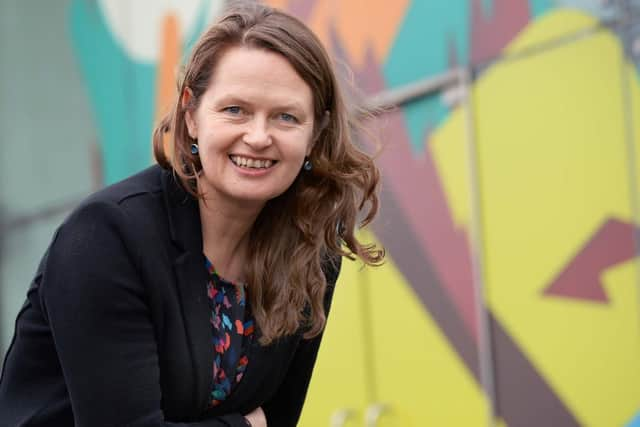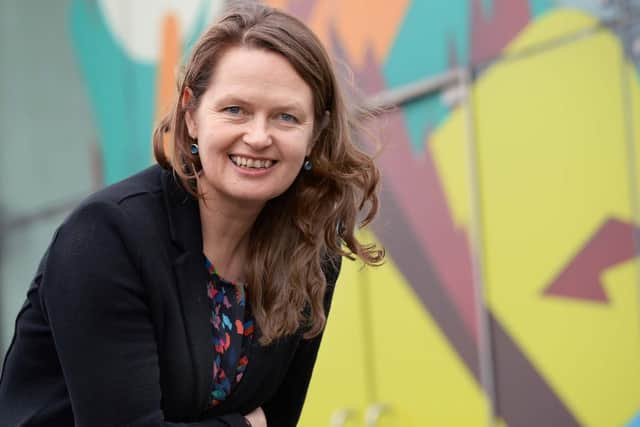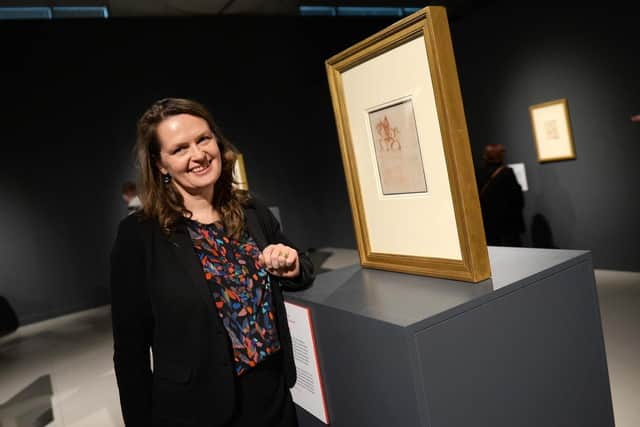Kim Streets interview: ‘The work museums do in Sheffield and across the UK makes this a better place to live’


Kim Streets, who runs the venue as chief executive of Museums Sheffield, looks thrilled as she surveys the scene while being photographed.
The free exhibition, A Life In Drawing, has had the best opening week of any show in the city for the past 10 years – if this sets a pattern, the attendance figure could be the museums' highest ever, beating the likes of Andy Warhol and Eric Ravilious.


2019, then, should be a very good year, thinks Kim.
Advertisement
Hide AdAdvertisement
Hide Ad"We've got extraordinary things, I'm feeling really positive," she says, pointing out that Museums Sheffield's reach is spreading far and wide – a new exhibition at Two Temple Place in London has drawn heavily on its John Ruskin archive, while the da Vinci show is one of 12 happening around the country courtesy of the Royal Collection.
"It's great to be part of something that's national," says Kim of the Leonardo events, which come 500 years after his death.
"That's important, that we're part of a national sector that's doing good stuff. It's good in terms of that benchmarking and being part of a groundswell of civic museums that are all making a difference in their respective places."


In April she will have been chief executive for seven years - quite a while, I observe, prompting a laugh. "Thankyou for pointing that out," she says in her cosy office at Leader House, a repurposed domestic home next to the Millennium Gallery.
Advertisement
Hide AdAdvertisement
Hide AdThere have been 'challenges along the way', she admits, but her role still offers much excitement.
"I do love this job. I love it because of the people – we've got a really great team and I think the work museums do in the city, in the city region and across the UK is about making this a better place to live.
“There's a feelgood quality to the work we do and that's what drives me. No day's ever the same. Seven years in, it doesn't feel like I've been doing it for that long - the seven-year itch thing, I don't feel like that. There's so much more we can do."
Her interest was piqued by a report published last week by the Centre for London think tank, which called on the capital and the North to forge a stronger relationship, following research which showed London had an image problem with the rest of the country.
Advertisement
Hide AdAdvertisement
Hide AdOne proposal was for museums in the capital to send their treasures on tour more often.
Kim talks of 'challenging that North-South divide', and is magnanimous about the success of neighbouring city Manchester, which managed to secure £80m of funding from central Government for its Factory arts centre.
"You have to see it as a network. It's not just about one city over another. If we're performing well in the north we're performing well in the south. I'm not into the partisan 'We was robbed' thing.
“I don't think it works like that, you have to see it in the round, we're all part of UK plc. It's certainly how I feel about culture. All of our cities have got something to bring and we need to be supportive of each other."
Advertisement
Hide AdAdvertisement
Hide AdGreater Manchester, of course, satisfied the Government by putting its devolution deal into action, something the Sheffield City Region has so far failed to do. Streets won't be drawn on politics, but believes there is no reason Sheffield could not win similar funding for a cultural landmark if it takes the right approach.
"What you see when you see Manchester getting funding for Factory is very strong leadership, a very clear vision, being in the right place at the right time, good relationships across the board, and that's what we're working on here.
“I'd like us to be in a position to be able to secure some substantial investment from Government for the city in, for example, the Graves Gallery in the future."
At the end of 2017, the city council said Sheffield was to get a brand new Central Library, while the existing Graves Art Gallery building on Surrey Street – previously mooted as the site of a five-star hotel - would be turned into a 'cultural hub'.
Advertisement
Hide AdAdvertisement
Hide AdThe Hepworth in Wakefield was mentioned as a comparison and Museums Sheffield was asked to lead on plans for the hub, but later it emerged that the option of keeping the library and gallery together in their present location was still on the table.
"We're still exploring the potential for the building," she says. "We all see that massive potential for the building to be transformed, to really invest in it so it becomes a really fabulous place.
“It's investing in reading and art, but it's also a flagship, it will draw people from across the city region and further afield. It will bring new life into the city centre. You can already see that. It could be the catalyst for something new."
The investment, she stresses, is 'not for now'. "It's really for the next 50 years. We need to be thinking 'What will the next three generations of Sheffield people see? What skills will we need to live in a mid-21st century world?'
Advertisement
Hide AdAdvertisement
Hide Ad“Our population will need to be super-creative, to be able to adapt and be flexible. To think, imagine and draw – a bit like Leonardo. That's what that building could do, it could really inspire our people. Just like it has done, all of its life. It's like an old friend, but an old friend that needs some TLC."
Kim showed the Graves Gallery to Sir Nicholas Serota, chair of potential funder Arts Council England, when he visited Sheffield for a tour last year. Serota, it turned out, had worked with Sheffield's former galleries director, the late Frank Constantine, as a young curator. However, it wasn't the time to ask for money, Streets says.
"We need to be clear about what the vision for the building might be and then be able to go knocking on the door of the Arts Council and others.
“The Arts Council aren't in the business of stomping into cities and dictating what shall happen. They very much want to work with."
Advertisement
Hide AdAdvertisement
Hide AdKim, who grew up in Selby, North Yorkshire, came to Sheffield in 1986 to study history at the polytechnic. After graduating she began volunteering at Kelham Island Museum, which showed her for the first time how a venue was managed.
"I'd gone on the odd trip as a kid with school, but we're not big museum-goers in the family," she says. "I remember going with my little sister to the railway museum in York and to York Castle museum. I would have been seven or eight. I remember being absolutely enthralled."
She credits former Kelham Island curator David Bostwick, who looked after the social history collection, with showing her the importance of the stories behind exhibits.
"For example, we've got James Montgomery's tea set in the collection. He was a radical writer who campaigned against the slave trade and for the working conditions of children in the city – to be able to hold in my hand his cup, or his pounce pot, and know that story, was massively inspiring. To learn that from somebody like David was an absolute privilege."
Advertisement
Hide AdAdvertisement
Hide AdSheffield's rich heritage 'triggered something' in her, she says. Her first paid job was as a documentation assistant with Lincolnshire's museums – then, in 1991, she returned to Sheffield to be the assistant keeper of social history. "It was a good place to be," she remembers.
In 1998 Museums Sheffield was formed as an independent charity, taking over from the city council, and during the 2000s the organisation was much more generously funded. Weston Park Museum, for example, was redeveloped at a cost of £19 million.
"It was a treat to work on that," Kim recalls. "To be able to create the Sheffield Life and Times Gallery and work on such a big capital project – it was a real buzz.
“I think about what we might do with the Graves and Central Library now and I look back to the amount of money we had in the 2000s and think 'Let's hope that time comes round again'. It is very cyclical. I think the day will come when we can transform the Graves, for sure."
Advertisement
Hide AdAdvertisement
Hide AdIn 2011 Museums Sheffield had to make major job cuts, shedding 45 posts, when Arts Council England refused £4.2 million in grants. The tough experience hasn't been forgotten.
"In terms of what we're delivering, we've recovered, we're in good shape. It's kind of institutional memory – for the people who went through that, came out the other end and survived it, it's always there. That uncertainty, the way you feel, it never entirely leaves you."
In the short term, the museums are getting a boost from Ambulo, the stylish new cafés at Weston Park and the Millennium Gallery, run by Arctic Monkeys drummer Matt Helders and the Rockingham Group, the firm behind Public, The Great Gatsby and other city bars.
Kim says these will be a destination in their own right. "What's not to love? It does feel really exciting to have great coffee, cocktails and food alongside great art and heritage."
Advertisement
Hide AdAdvertisement
Hide AdShe wants to give more people the opportunity to see Museums Sheffield's vast stores – "It would come as part of a bigger masterplan" – and is preoccupied with the notion of 'collecting for the future' by making the city's exhibits more representative of people's lives today.
"We do need people to help with that. It's something really fundamental to the future of museums, that they are relevant to us all."
She is also a member of the Sheffield Culture Consortium, so is well-versed in local schemes such as the planned Park Hill Art Space and Site Gallery's expansion, now completed. "We're not short on good ideas," she says.
Kim, aged 50, is married to artist Steve Pool. She has three grown-up children and lives in Pitsmoor. "I'm really proud of living there, and bringing my kids up there.
Advertisement
Hide AdAdvertisement
Hide Ad“Sheffield is such a culturally rich place. I see it every day in Pitsmoor - in the kindnesses you see, the lovely neighbours and the good food from around the world.
“There's two places that remind me Sheffield is an international city – the Millennium Gallery, and Pitsmoor. Right now, in the middle of Brexit chaos, that's something to be proud of."
Art highlights for 2019
A retrospective of Sheffield artist Joe Scarborough, a look at realism in British art and a display of ceramics are among the highlights of Museums Sheffield's 2019 programme.
The Scarborough show will be at Weston Park Museum from August to November, while an exhibition dedicated to 'kitchen sink' pieces in Sheffield's collection, produced by artists from 1945 to 1975, is happening this summer.
Advertisement
Hide AdAdvertisement
Hide AdFrom May to September, another exhibition commemorating John Ruskin's bicentenary is taking place called 'Art and Wonder', and from August to October the work of ceramicist Emily Taylor will come under the spotlight at the Millennium Gallery.
Leonardo da Vinci: A Life in Drawing runs until May 6.